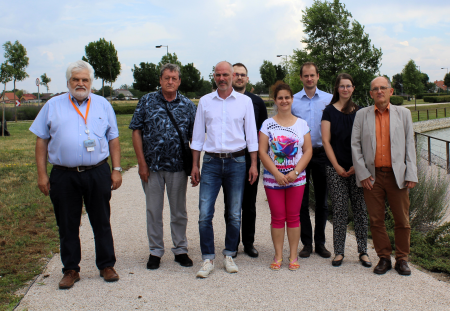HUN-REN–SZTE Research Group for Photoacoustic Monitoring of Environmental Processes
Introduction
The HUN-REN–SZTE Photoacoustic Environmental Process Monitoring Research Group is a joint research group maintained by the Hungarian Research Network and the University of Szeged. The group was founded in 2013 by Prof. Gábor Szabó (Chairman of the Board of Trustees of the University of Szeged) and has been led by Prof. Zoltán Bozóki since 2022. Through its research, published in prestigious international scientific journals, the group contributes to the practical adoption of photoacoustic measurement methods in fields such as environmental protection and atmospheric chemistry. We place special emphasis on supporting the professional careers of young researchers and popularizing physics, and we also aim to establish R&D collaborations with as many Hungarian companies as possible.
Research Topics
Instrument and Method Development
The project includes the development of a measurement system capable of simultaneously measuring the flux of greenhouse gas and stratospheric ozone-depleting N₂O along with NH₃. These gases are emitted from the soil, but can also be released by plants. Climate chamber experiments are planned. A model will be developed to simulate NH₃ and N₂O fluxes between the soil–plant system and the atmosphere.
Another task involves the testing, calibration, and analytical parameter determination of an open-chamber photoacoustic (PA) measurement system for measuring aerosol particle concentrations. Numerical modeling of flow-acoustic and PA signal generation will be carried out, considering increased flow velocity. Plans will be developed for drone deployment and field application of the PA system. The integration and testing of the laser light source and open chamber will also be conducted.
A measurement setup will be developed for the controlled laboratory modeling of laser-induced biomass and elemental carbon (soot) particles. Cross-interference effects in the gas phase and their impacts will be explored.
Field Measurements
One of the objectives is to continuously measure NH₃ and N₂O fluxes using high-frequency PA measurements and the eddy covariance method over croplands. In addition, we plan supplementary soil, plant, and meteorological measurements, with continuous monitoring of NH₃ and N₂O emissions from the soil at multiple points. The goal is to measure total emissions from the vegetation and soil in parallel, in order to distinguish between plant and soil sources of NH₃ and N₂O.
Modeling of NH₃ and N₂O fluxes between the soil–plant system and the atmosphere is planned, including model development, testing, and application.
Climate Chamber Studies
Pot experiments will be conducted in climate chambers. NH₃ and N₂O concentrations will be measured using the PA method separately for plants and soil, to determine the extent of gas exchange between the soil–atmosphere and plant–atmosphere interfaces.
The effect of plant drought stress and nitrogen supply on gas emissions will be assessed. We aim to estimate the impact of climate change on emissions. A key question is how climate-change-related abiotic plant stresses (e.g., heat and drought stress), which are becoming more frequent, influence emissions. Chlorophyll fluorescence studies will be conducted under stress and control conditions.
High-precision, ppb-level measurement of the ¹⁴N/¹⁵N isotope ratio using the PA method will be developed. This ratio will be used to track processes in the soil–plant–atmosphere system, as all physical and chemical transformations involve changes in isotope enrichment. Since ¹⁵N has a natural abundance of only 0.36%, enrichment may be necessary using ¹⁵NH₄Cl. Further investigations include applying the ¹⁵N tracer technique using both ¹⁵NH₄⁺ and ¹⁵NO₃⁻. Combining the two labeling methods and measuring the isotope ratios of emitted gases can yield critical insights into the mechanisms of poorly understood soil processes.
Combustion Particle Studies
Biomass- and low-maturity elemental carbon particles will be produced under controlled laboratory conditions and studied via photoacoustic methods. Wavelength and laser parameter selection for PA system development will be performed. Resonator and PA detector units will be designed and developed. An open-chamber system for drone deployment will be designed and developed. The spectral response and energy characteristics of biomass-derived particles will be studied using the drone-mounted system. Atmospheric emission measurements will be conducted. Laboratory measurements of tar ball particle spectral responses will be performed. Emission studies of savanna fires will be carried out in international collaborations. A measurement model will be developed and finalized to investigate the spectral responses of biomass-derived particles. The applicability of spectral responses for identifying the biomass source of emissions will be validated. Climate impact estimates will be made. The applicability of drone-mounted PA systems will be assessed both near emission sources and in remote environments. The spectral response will be analyzed for composition and source characteristics.
More about the group’s work can be found here, here and here.



